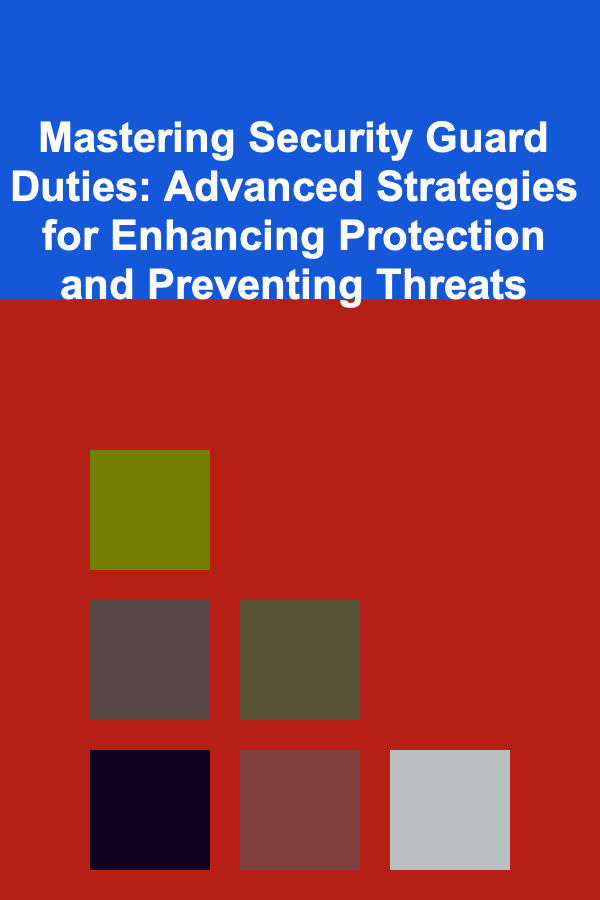
Mastering Security Guard Duties: Advanced Strategies for Enhancing Protection and Preventing Threats
ebook include PDF & Audio bundle (Micro Guide)
$12.99$10.99
Limited Time Offer! Order within the next:

Security guards play an essential role in maintaining the safety and security of properties, individuals, and sensitive assets. However, the role of a security guard goes far beyond merely observing and reporting. It requires advanced strategies, a deep understanding of various security systems, and the ability to handle diverse situations with precision and skill. This actionable guide delves into the core techniques and advanced strategies that security guards can adopt to enhance protection and prevent potential threats.
Understanding the Core Functions of a Security Guard
Before diving into advanced strategies, it is critical to understand the core responsibilities of a security guard. These responsibilities include:
- Surveillance: Continuously monitoring an area to detect suspicious activities.
- Access Control: Ensuring that only authorized individuals are allowed access to secure areas.
- Emergency Response: Reacting swiftly and effectively to emergencies, including medical incidents, fires, and security breaches.
- Patrolling: Actively observing and inspecting an area to ensure everything is secure.
- Report Writing: Documenting all observations, incidents, and actions taken during shifts.
A security guard's role requires a mix of preventive actions, reactive strategies, and the use of advanced tools. Mastery of these functions can significantly enhance the protection of the premises, people, and property under a guard's care.
Advanced Surveillance Techniques
Surveillance is a fundamental part of a security guard's role, but traditional methods may not always be enough in high-risk environments. Below are advanced strategies to improve surveillance effectiveness.
2.1 Leveraging Technology for Enhanced Monitoring
While traditional surveillance tools like CCTV cameras are essential, modern technologies offer advanced solutions that security guards can utilize for more effective monitoring.
- Integrated Security Systems: Many security systems now offer integration between CCTV cameras, alarm systems, and access control. This integration provides real-time alerts, allowing security guards to monitor multiple aspects of the facility simultaneously. Guards should be trained to manage these systems and understand how to act on information from multiple sources in real-time.
- AI-Powered Surveillance: AI-based tools can help detect unusual behavior patterns and identify potential threats before they escalate. For instance, facial recognition systems can spot known intruders, and behavioral analysis software can flag suspicious activity such as loitering or unauthorized access to restricted areas. Guards should familiarize themselves with these AI systems to efficiently review footage and identify risks.
- Drones for Aerial Surveillance: In larger facilities, drones can provide a bird's-eye view of the premises. These tools allow for quick inspections of hard-to-reach areas like rooftops or sprawling grounds. Security guards should learn to operate drones or collaborate with teams who can deploy them quickly when necessary.
2.2 Active and Passive Monitoring Techniques
Security guards should practice both active and passive monitoring techniques for comprehensive surveillance:
- Active Monitoring: Actively observing key areas of interest, including high-risk zones, entrances, and exits. Guards should move strategically and change their position periodically to avoid predictability. This also prevents intruders from becoming aware of patterns in the guard's routine.
- Passive Monitoring: Using surveillance cameras, motion sensors, and alarm systems to monitor areas passively. Guards should ensure that these systems are properly maintained and calibrated to avoid false positives or missed alerts.
2.3 Mastering Situational Awareness
Situational awareness is crucial for spotting threats early. This concept involves being acutely aware of the environment, recognizing deviations from the norm, and responding proactively.
- Understanding Behavior: The ability to identify suspicious behavior is more important than identifying suspicious people. People acting strangely---such as sneaking around restricted areas, avoiding eye contact, or loitering near entrances---should be closely monitored.
- Proactive Threat Identification: Instead of waiting for a threat to escalate, guards should actively seek out vulnerabilities. This includes checking for signs of forced entry, unlocked doors, or malfunctioning security systems that could be exploited by an intruder.
Advanced Access Control and Security Protocols
Access control is at the heart of most security operations, ensuring that only authorized individuals are allowed entry into secure or restricted areas. Effective access control prevents unauthorized access and minimizes the potential for insider threats.
3.1 Using Biometric and Smart Access Systems
With advances in technology, security guards can implement more robust access control systems beyond traditional keycards or PIN codes. These systems offer greater accuracy and security:
- Biometric Systems: Fingerprint scanners, retina scans, and facial recognition are becoming standard in high-security environments. Guards should ensure that biometric systems are working correctly and learn to troubleshoot basic issues with these systems.
- RFID and Smart Cards: Radio Frequency Identification (RFID) tags and smart cards offer a secure method for identifying individuals. These can be paired with time-based access control to ensure that certain areas are only accessible during specific hours.
3.2 Multi-Factor Authentication (MFA)
MFA adds a layer of security to access control by requiring two or more verification methods before granting access. Guards should be familiar with how these systems work, which may include biometric authentication, smart cards, or PIN codes.
- Protocol for Handling MFA Failures: Guards should have clear protocols for handling MFA failures, such as immediately verifying the identity of the individual attempting access, checking the access log, and escalating issues if unauthorized access is attempted.
3.3 Proactive Threat Mitigation
The best way to prevent unauthorized access is to reduce opportunities for security breaches. Security guards should monitor access points and look for indicators that someone is trying to bypass security, such as tampering with locks or entering through non-designated routes.
Handling Emergencies: Advanced Crisis Management
An effective security guard is not only a deterrent to crime but also a skilled first responder during emergencies. Advanced crisis management involves acting quickly, efficiently, and calmly in high-stress situations.
4.1 Developing a Deep Understanding of Emergency Protocols
Security guards should be well-versed in emergency protocols for a range of scenarios. This includes but is not limited to:
- Fire Evacuation Plans: Knowing fire escape routes, understanding the locations of fire extinguishers, and how to safely evacuate people from the building.
- Medical Emergencies: Security guards should be trained in advanced first aid, including CPR, AED use, and treating injuries until medical professionals arrive.
- Active Shooter and Violent Incident Protocols: In extreme cases, such as an active shooter scenario, security guards must be able to respond quickly. They should know when to evacuate, when to contain the threat, and when to engage law enforcement.
4.2 Crisis De-escalation Techniques
De-escalating tense situations is a critical skill that can prevent violence and ensure safety without resorting to force. Security guards should:
- Communicate Calmly and Effectively: Guards should use calm, clear language to guide individuals during an emergency. Aggressive or rushed communication can escalate the situation.
- Establish Authority Without Aggression: Guards must establish themselves as figures of authority in the crisis without being overly forceful. Non-threatening body language and a firm but respectful tone are essential.
4.3 Coordinating with Law Enforcement
In certain emergencies, it is crucial to coordinate with law enforcement or emergency response teams. Guards should have direct communication channels with local authorities, ensuring swift handover of information and full cooperation.
Mastering Defensive and Offensive Security Strategies
While security guards primarily focus on preventing threats, they must also be prepared to respond in situations where defense becomes necessary.
5.1 Defensive Security: Protecting Yourself and Others
Security guards should be trained in defensive tactics to protect themselves and others in dangerous situations. This includes:
- Non-Lethal Self-Defense Techniques: Guards should be trained in methods such as pepper spray, tasers, and physical restraint techniques to de-escalate confrontational situations.
- Escape and Evasion: In extreme situations, guards may need to escape or hide to preserve their safety while still managing to alert authorities or guide people to safety.
5.2 Offensive Security: Deterrence and Immediate Response
Sometimes, immediate intervention is necessary to neutralize a threat. Guards should be prepared to respond decisively:
- Confronting the Threat: When a security breach occurs, guards must act swiftly to contain the situation. Whether this involves confronting an intruder or initiating lockdown protocols, guards should have clear, effective methods for neutralizing the threat.
- Using Security Tools: Guards should be well-versed in utilizing security tools, such as communication devices, alarm systems, and surveillance equipment, to enhance their response in real-time.
Conclusion: Building a Culture of Excellence in Security
Mastering security guard duties requires both technical expertise and the ability to think critically in high-pressure situations. The most effective security guards use advanced surveillance techniques, employ cutting-edge access control systems, respond expertly during emergencies, and practice defensive and offensive strategies when needed. By investing in training, mastering advanced tools, and developing strong crisis management skills, security guards can not only enhance protection but also prevent threats before they materialize.
Ultimately, security is not just about reacting to incidents but proactively identifying and mitigating potential risks. By refining their skills and staying updated with the latest developments in security technologies and protocols, security guards can ensure a safe and secure environment for everyone.

How to Make Money Online as a YouTube Scriptwriter: 10 Actionable Ideas
Read More
How to Organize Your Small Kitchen for Maximum Space Utilization
Read More
How to Renovate Your Home's Windows for Better Insulation
Read More
Top Tips for Effectively Utilizing Digital Banking and Budgeting Tools
Read More
How to Understand the Future of Robotics in Society
Read More
How to Build Community Resilience to Extreme Weather
Read MoreOther Products

How to Make Money Online as a YouTube Scriptwriter: 10 Actionable Ideas
Read More
How to Organize Your Small Kitchen for Maximum Space Utilization
Read More
How to Renovate Your Home's Windows for Better Insulation
Read More
Top Tips for Effectively Utilizing Digital Banking and Budgeting Tools
Read More
How to Understand the Future of Robotics in Society
Read More